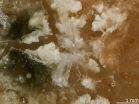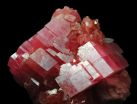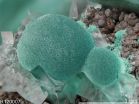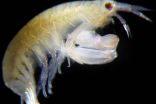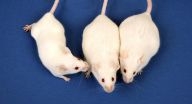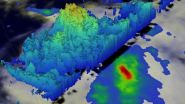(Press-News.org) Washington, DC--New research from a team led by Carnegie's Robert Hazen predicts that Earth has more than 1,500 undiscovered minerals and that the exact mineral diversity of our planet is unique and could not be duplicated anywhere in the cosmos.
Minerals form from novel combinations of elements. These combinations can be facilitated by both geological activity, including volcanoes, plate tectonics, and water-rock interactions, and biological activity, such as chemical reactions with oxygen and organic material.
Nearly a decade ago, Hazen developed the idea that the diversity explosion of planet's minerals from the dozen present at the birth of our Solar System to the nearly 5,000 types existing today arose primarily from the rise of life. More than two-thirds of known minerals can be linked directly or indirectly to biological activity, according to Hazen. Much of this is due to the rise of bacterial photosynthesis, which dramatically increased the atmospheric oxygen concentration about 2.4 billion years ago.
In a suite of four related, recently published papers, Hazen and his team--Ed Grew, Bob Downs, Joshua Golden, Grethe Hystad, and Alex Pires--took the mineral evolution concept one step further. They used both statistical models of ecosystem research and extensive analysis of mineralogical databases to explore questions of probability involving mineral distribution.
They discovered that the probability that a mineral "species" (defined by its unique combination of chemical composition and crystal structure) exists at only one locality is about 22 percent, whereas the probability that it is found at 10 or fewer locations is about 65 percent. Most mineral species are quite rare, in fact, found in 5 or fewer localities.
"Minerals follow the same kind of frequency of distribution as words in a book," Hazen explained. "For example, the most-used words in a book are extremely common such as 'and,' 'the,' and 'a.' Rare words define the diversity of a book's vocabulary. The same is true for minerals on Earth. Rare minerals define our planet's mineralogical diversity."
Further statistical analysis of mineral distribution and diversity suggested thousands of plausible rare minerals either still await discovery or occurred at some point in Earth's history, only to be subsequently lost by burial, erosion, or subduction back into the mantle. The team predicted that 1,563 minerals exist on Earth today, but have yet to be discovered and described.
The distribution of these "missing" minerals is not uniform, however.
Several circumstances influence the likelihood of a mineral having previously been discovered. This includes physical characteristics, such as color. White minerals are less likely to have been noticed, for example. Other factors include the quality of crystallization, solubility in water, and stability near the surface of the planet.
As such, Hazen and his colleagues predicted that nearly 35 percent of sodium minerals remain undiscovered, because more than half of them are white, poorly crystallized, or water soluble. By contrast, fewer than 20 percent of copper, magnesium, and copper minerals have not been discovered.
Further expanding the link between geological and biological evolution, Hazen's team applied the biological concepts of chance and necessity to mineral evolution. In biology, this idea means that natural selection occurs because of a random "chance" mutation in the genetic material of a living organism that becomes, if it confers reproductive advantage, a "necessary" adaptation.
But in this instance, Hazen's team asked how the diversity and distribution of Earth's minerals came into existence and the likelihood that it could be replicated elsewhere. What they found is that if we could turn back the clock and "re-play" Earth's history, it is probable that many of the minerals formed and discovered in this alternate version of our planet would be different from those we know today.
"This means that despite the physical, chemical, and biological factors that control most of our planet's mineral diversity, Earth's mineralogy is unique in the cosmos," Hazen said.
The four papers are published in Canadian Mineralogist, Mathematical Geoscience, American Mineralogist, and Earth and Planetary Science Letters.
INFORMATION:
PHILADELPHIA - In the midst of a growing trend for Medicare patients to receive observation care in the hospital to determine if they should be formally admitted, a new study from researchers at the Perelman School of Medicine at the University of Pennsylvania shows that for more than a quarter of beneficiaries with multiple observation stays, the cumulative out-of-pocket costs of these visits exceeds the deductible they would have owed for an inpatient hospital admission. According to the Medicare Payment Advisory Commission, there were 1.8 million observation patients ...
BATON ROUGE - Ten years after Hurricanes Katrina and Rita devastated the Gulf Coast, LSU researchers have analyzed and documented the recovery effort for the state. Initial reports have been released this week.
Due to the unprecedented destruction of the 2005 storm season, recovery efforts traditionally supported by insurance and FEMA were supplemented by a unique set of programs funded through $13.4 billion of Community Development Block Grant-Disaster Recovery, or CDBG-DR funds.
The researchers from the LSU AgCenter and E. J. Ourso College of Business focused on ...
New Haven, Conn. -- Nearly one in four patients with chronic hepatitis C (HCV) are denied initial approval for a drug therapy that treats the most common strain of the infection, according to a Yale School of Medicine study.
The finding, published Aug. 27 in PLOS ONE, identifies a new barrier to caring for patients with this severe condition.
Prior to the FDA approval of novel antiviral therapies for HCV in 2014, treatment options for patients were limited, requiring weekly injections of interferon-based therapy that caused severe side effects. The new regimens revolutionized ...
For astronauts living in space with objects zooming around them at 22,000 miles per hour like rogue super-bullets, it's good to have a backup plan. Although shields and fancy maneuvers could help protect space structures, scientists have to prepare for the possibility that debris could pierce a vessel. In the journal ACS Macro Letters, one team reports on a new material that heals itself within seconds and could prevent structural penetration from being catastrophic.
It's hard to imagine a place more inhospitable to life than space. Yet humans have managed to travel ...
The Global Precipitation Measurement or GPM mission core satellite measured rainfall as Tropical Depression Twelve was upgraded to Tropical Storm Ignacio.
Tropical Depression 12E strengthened into Tropical Storm Ignacio at 5 p.m. EDT yesterday, August 25. At that time, it became the ninth named tropical storm of the Eastern Pacific hurricane season.
The GPM core observatory satellite saw Ignacio on August 25, 2015 at 2256 UTC. GPM's Dual-Frequency Precipitation Radar (DPR) found rain falling at a rate of over 74 mm (2.9 inches) per hour with storm tops reaching to altitudes ...
Treatments for cystic fibrosis (CF) have added years to the lives of thousands of Americans. But they can be difficult to administer, and most don't fix the underlying cause. Scientists have now found that a small molecule, when tested in yeast, can substitute for a protein and restore a key cellular function related to those missing in people with CF and similar conditions. Their report appears in the Journal of the American Chemical Society.
CF is caused by a genetic mutation that affects certain cellular proteins that make up "channels," which act like gates managing ...
Nobody likes flight delays, but they are a common occurrence: In 2011, about 20 percent of U.S. flights were at least 15 minutes behind schedule. Those delays irritate passengers and, in 2010, added an estimated $6.5 billion to U.S. airlines' operating costs.
Delays tend to hit some airlines harder than others, due to the approach the Federal Aviation Administration (FAA) uses to resolve them. This approach places an emphasis on minimizing aggregate system delays, nationwide -- a policy that affects some airlines much more than others at a given time.
But now a study ...
While exploring the remote coral reefs of Raja Ampat in Indonesia, Dr. James Thomas from the Halmos College of Natural Sciences and Oceanography, Florida, and his colleagues from Naturalis Natural History museum in the Netherlands, stumbled across a small but extraordinary crustacean living inside another reef invertebrate in a commensal association (without causing any harm, nor benefit to its host).
In his amazement to the amphipod's unusual form, Dr. Tomas called it L. eltoni after musician and actor Sir Elton John. The research is available in the open access journal ...
Female mice exposed in utero, or in the womb, to low levels of arsenic through drinking water displayed signs of early puberty and became obese as adults, according to scientists from the National Institutes of Health. The finding is significant because the exposure level of 10 parts per billion used in the study is the current U.S. Environmental Protection Agency standard, or maximum allowable amount, for arsenic in drinking water. The study, which appeared online August 21 in the journal Environmental Health Perspectives, serves as a good starting point for examining ...
The Global Precipitation Measurement or GPM mission core satellite can measure rainfall from space, and saw heavy rainfall in the Central Pacific's Loke when it was a hurricane.
Hurricane Loke formed southwest of the Hawaiian Islands on August 21, 2015 but Loke has not been a threat to Hawaii because it intensified to hurricane strength while moving well west of Hawaii over the open waters of the Pacific Ocean.
The GPM core observatory satellite measured precipitation within the hurricane as it flew above the most powerful thunderstorms in the hurricane on August 25, ...
